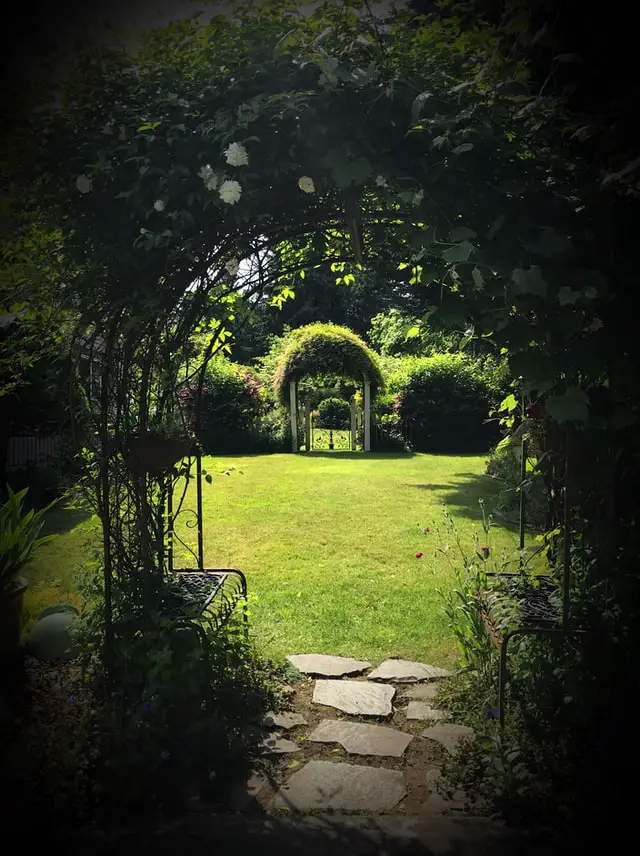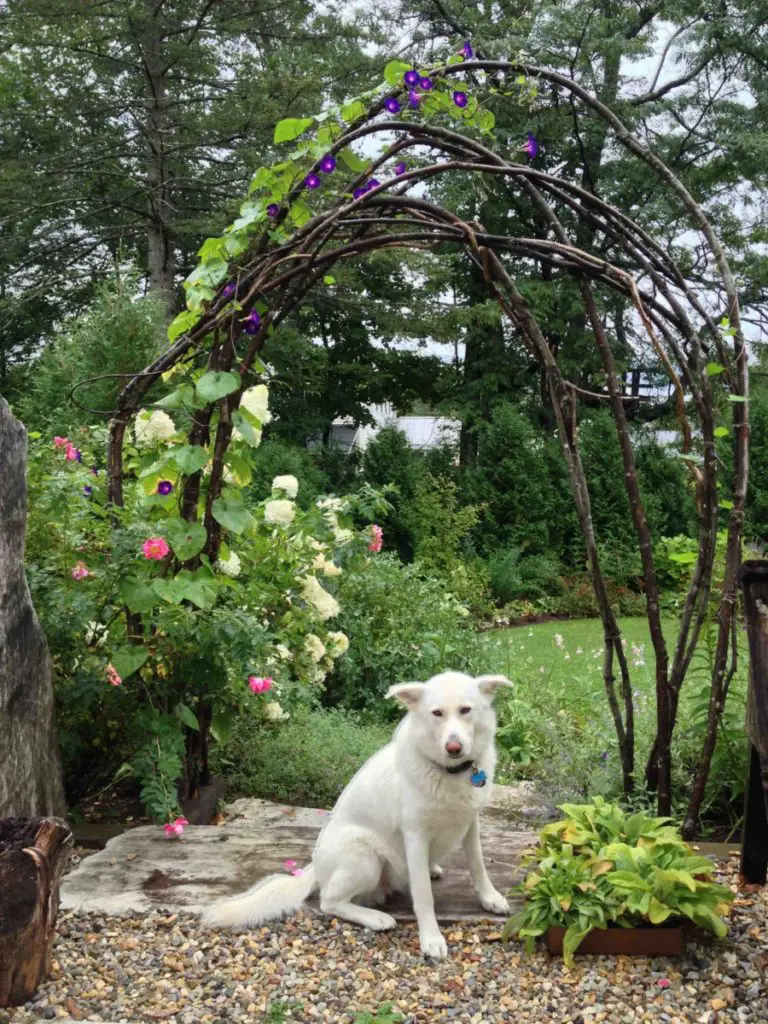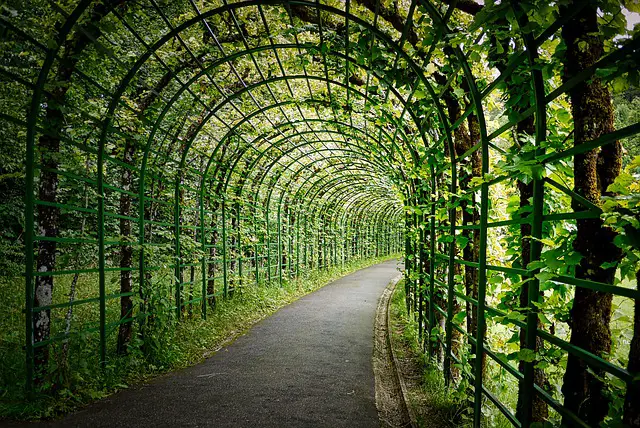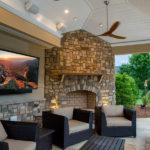Garden arches are one of the most beautiful additions you can make to your yard. Not only are they aesthetically pleasing, but they serve many purposes. With options available in a huge range of sizes and styles, almost any yard can be improved with garden arches.
This guide will cover the history and uses of garden arches and yard arbors. It will offer advice on how they can be installed as decorative and practical features. We’ll discuss styles, materials, and go over some of the best plants to use when creating a garden arch. To top it off, we’ll cover how to construct a DIY garden arch and whether you should choose a custom-built or pre-made design.
History of Garden Arches
Garden arches have been popular features in private and public gardens for thousands of years. While the materials used for their construction and popular styles have varied throughout the years, the same basic idea of an attractive feature that provides shade has remained consistent.
The Roman Pergola
The Ancient Greeks and Romans constructed trellises and gazebos to provide shade and to train vines. The Late Latin word pergula means “projecting eave,” and a pergola refers to a type of garden arch that provides a shaded walkway.
A pergola should not be confused with an arbor (although these also date back to classical times). An arbor refers to a seat covered by a protective arch, while a pergola may often be a series of arches protecting a walkway. The heat of the Mediterranean summers and the popularity of climbing plants such as roses and grapevines make these features practical as well as beautiful additions to gardens.
Chinese Gardens
Classical Chinese gardens often featured pavilions or gazebo-like structures that may have had some similarity to the garden arches found in Europe. Carefully designed and maintained gardens in China have existed for several millennia, and arbor-like designs would have provided shade. However, they may not have been designed for climbing plants to the same extent as their Greek and Roman counterparts.
Renaissance Green Tunnels
During the Renaissance period in Europe, structures known as green tunnels were very popular. These structures differ from pergolas and other arches in that they are made from living trees bound together at the top. This, in turn, forms an archway.
Garden Arches Today
Garden arbors and arches experienced a revival during the late 19th Century as private gardens became more affordable and accessible to homeowners. The declining popularity of the English “landscape” garden that disdained strict geometric features also contributed to their resurgent popularity.
Today they are popular around the world in public and private gardens. They’re valued for their distinctive aesthetic value and their ability to provide shade, especially in warmer climates. The best gardens always have something extra and garden arches offer a way to spruce up any space.
Uses of Garden Arches
People install garden arches for many reasons. Below are some of the most popular ways these features are used.
Training Vines
Climbing plants require a surface to grow around, and the lattice design of many garden arches is ideal for this. Roses are a very popular option, while grapevines were one of the favored plants in classical times.
There are a huge number of plants that can be trained to grow on these features. Popular choices tend to be flowering plants as this contributes to the aesthetic appeal of the feature. However, thick climbing plants such as ivy can also be used, especially if the feature’s main purpose is to provide shade.
Providing Shade
Shaded areas of gardens are popular in warmer climates for pastimes such as relaxing while reading a book, dining, or even just whiling away the hours away from the glare of the sun. Longer archways like pergolas keep extended walkways shady and cool. It allows for a wide variety of climbing plants to be trained in a single tunnel, creating a beautiful journey.
Garden arbors are distinguished by the presence of a seat beneath the shaded area. A yard arbor is a popular feature in smaller gardens because it takes up less room, but garden arbors are also popular in larger gardens as places for rest that can be dotted around the yard. These can be shaded by design, or the shade can be provided by climbing plants that grow through the trellises.
Marking an Entrance
Garden arches are sometimes used to denote the entrance to a pathway or a particular part of a yard. Suppose your yard is large enough to be separated into different sections. In that case, these features can be an excellent choice for distinguishing one area (such as a dining area) from another (such as an area with a pond or a children’s play area).
Even the outside entrance to your home can be marked with an attractive arch. In this sense, they are used as practical markers and statement pieces that contribute to the aesthetics of your yard.
Aesthetics
Perhaps the most popular use of garden arches is simply to make your garden more beautiful. A well-placed yard arbor can add a sense of grandeur even to a smaller area, for example. Space may be limited, but as the main dimension of a yard arbor is its height, it can make a space seem larger and more inviting as a place to rest and relax.
The wide variety of climbing plants that can be grown on a yard arbor or garden arch make them popular with keen gardeners. They can allow you to grow plants that may struggle in a completely flat environment, and maintaining a beautiful yard arbor or garden arch is the kind of labor of love that keen horticulturalists relish.
Brush Arbor Revivals
In some Christian denominations such as the Methodist and Baptist churches, garden arbors are used for a type of meeting called a brush arbor revival. These types of structures always involve seating and are typically roofed with cut branches or hay. In these cases, the garden arbors serve almost as makeshift churches.

Garden Arch Placement
There’s no such thing as a “best place” for a garden arch or yard arbor — it depends on the layout of your yard and what you want to use it for. However, below are some common placement choices for these features.
Over Seating as an Arbor
Many garden arbors are sold as arbors, meaning that the seating comes with the garden arch. In these cases, it might be integrated or fully attached to the arch. This can be an attractive choice as it means the design of the seating will match the frame of your yard arbor.
You can also create a yard arbor by placing a garden arch over an existing area of seating. This is usually a bench or chair instead of a dining area, in which case the cover would be a pavilion or gazebo. If you have a favorite spot in your yard to sit and read a book or simply relax, placing an arch in that location to turn it into a yard arbor is an excellent choice.
At the Start of Pathways
Larger yards with pathways often use a garden arch to mark the beginning of the pathway as a kind of entrance or open gate. This feature may be decorated with plants and lights and can be especially attractive if you have guests over in the evening; “taking a turn around the yard” on evenings with good company is always a pleasing idea.
Of course, you don’t have to decorate these features with plants. A simple metal arch can be all you need to create an attractive opening to a pathway — decorative options are all up to you.
Along Pathways
Shaded pathways protected by a pergola are a wonderful feature in any yard, especially in warmer climates. These can create a tunnel-like area to walk through and may lead to a larger shaded area such as a pavilion where dinner can be enjoyed outdoors.
You can choose between pergolas that have an almost closed trellis to create shade or use climbing plants to protect the pathway from the sun. Of course, you don’t have to fully shade a path — incidental garden arches with areas exposed to the sun in between can also create a wonderful environment to take a stroll.
In Front of a View
If your yard overlooks a spectacular view, such as a valley or the ocean, framing it with a garden arch is a great choice. You could also install a yard arbor in this area so that you can sit and enjoy the view to your heart’s content. Even if you choose not to have a seating area, placing an arch that acts as a kind of gate to a beautiful view always has an impressive and dramatic effect.
As a Centerpiece
You can place an arch or yard arbor anywhere. Especially if you’re decorating it with beautiful climbing plants, it can form an extremely attractive centerpiece for your yard. Arches placed in more open locations are also very appealing to children, who may enjoy chasing each other through and around the arch.
What to Consider When Buying a Garden Arch
Below are some of the most important considerations when buying a garden arch.
Size
You typically won’t see a pergola in a smaller yard simply because of size constraints, but the good news is that there are attractive garden arbors and arches that fit neatly into almost any outdoor space.
The height of these structures tends to be fairly consistent at around 7ft. This makes it tall enough for most people to comfortably pass through, although if you’re planning on decorating it with climbing plants (especially if that plant grows thorns), you may wish to opt for a taller model as the plants may intrude into your headspace.
You should also consider width — if the purpose of the garden arch is for people to walk through, it should be reasonably wide. It should also fit neatly in the area you intend to place it — if it’s going on a pathway, measure the width of the pathway before making a purchase.
If you’re planning to install your own seating for a yard arbor, make sure that it’s wide enough to accommodate your seats. This is one advantage of buying a yard arbor that comes with seating that is already designed to fit underneath the structure.
Materials
Garden arches tend to be made from either wood, metal, or vinyl, with each material having advantages (see below). Your choice of material may depend on several factors:
Price: some wooden arches can be quite expensive depending on the wood used, while vinyl arches tend to be more affordable.
Durability: especially if you have young children, choosing a sturdy material that doesn’t scratch easily can be preferable.
Climate: wood tends to suffer more than metal in cold conditions. Meanwhile, if you’re planning to grow plants on the structure and live in a hot environment, consider that metal becomes extremely hot in direct sunlight, which can damage any plants in contact with the surface.
Style: choosing a material that fits in with your garden’s aesthetic is an important concern. Before making a purchase, consider what else you have in your yard, as well as any plans you might have for extra additions — what materials will you be using for those?
You might occasionally find garden arches made fully or partly from stone. While this can be very attractive, it tends to be less inviting for growing plants.
Style
There are almost limitless design choices for garden arbors and arches. Finding one that complements the aesthetics of your home and yard is one of the most exciting parts of the buying process, so remember to take your time and enjoy it!
You may even choose to have an arch designed specifically to fit in with your yard’s aesthetic. This can be more costly than selecting a pre-built model, but the extra investment will give you a beautiful and unique feature.
Purpose
What do you want your garden arch to do in your garden? This can influence your choice of material as well as the design. If you want to grow climbing plants, choose a model with a wider trellis design that gives the plants sometimes to attach to. If your primary use is for shade, and you don’t want to grow plants, you can choose a narrower trellis design or a garden arch that is filled in with bamboo or another material.
If you’re using it as an entrance for a pathway or another section of your yard, you may wish to choose a simple design that has less depth than more ornamental arches. This can save you money while still adding a striking feature to your yard.
Garden Arch Types
As mentioned, finding a garden arch that fits your home’s aesthetic style is one of the most enjoyable parts of the buying process. While design options are almost limitless, below are some popular choices to get you started.
Rustic
Rustic garden arches are typically made of wood and typically feature a simple trellis design. These are made for growing climbing plants and are an excellent choice for several reasons: Inexpensive. While the cost depends on your choice of wood, the simple design of these features (as well as their size, which is generally quite small) makes rustic garden arches very affordable. Great for plants. The open design of rustic trellises means that plants have an easy time growing through the trellis. While you’ll want to maintain them regularly to avoid branches obstructing the path, these are a perfect choice for keen gardeners for this reason.S mall size. These models are typically quite small and so can fit into yards with less space available. This also means that they’re excellent for placing along a winding path to form a pergola, as they’re not very deep, so they can handle corners well. Simple, attractive design. The rustic aesthetic fits well into almost any yard, making it one of the most popular garden arches today.
Arbors
Garden arbors have seating underneath the arch. They’re popular as they give you a sheltered place to rest and can provide an attractive piece of seating even in smaller yards.
When buying a yard arbor, it’s worth noting that many places equate arbors with arches of all kinds. A true arbor always has seating; however, you may find that garden arches without seating are also sold under this name. Of course, this doesn’t need to be a concern as you can always install your own seating under any garden arch, and it becomes a yard arbor!
Garden arbors come in a huge variety of designs but are often made of wood, as this tends to provide more comfortable seating. They’re perfect for decorating with climbing plants and may come with additional features such as planters on each side.
Gothic
The stately design of Gothic arches makes them an enduringly popular feature. These are usually made from metal and frequently painted black, creating striking gateways through your yard. Ideal uses of Gothic arches might be along a pathway or separating different sections of your yard.
They are less often used for climbing plants than other styles but can be adorned with lights for a breathtaking effect when night comes. They’re usually affordable depending on how ornate the design is and the type of metal used.
Wall Arches
These are half-arches that connect directly to a wall and are perfect for slightly smaller yards for this reason. They come in many styles — some are designed to accommodate climbing plants, while others may have a spare frame that simply provides an attractive gateway.
Round
Wide, round garden arches are increasingly popular and give a contemporary feel to your yard. These may be almost full circles or simply wide, curving arches that are excellent for pathways.
Round garden arches are typically made out of wood or metal, although metal tends to be more common. They’re usually good for climbing plants, and the width of the roof means that a series of these arches can create a gorgeous tunnel or pergola when adorned with plants. As they’re so wide, they tend to work best in larger yards.
These models may be freestanding or can be anchored to the ground. This is worth noting if you have smaller children as this style is very inviting to climb on.
Garden Arch Materials
The choice of material you use for your garden arch depends on your budget and aesthetic preferences, as well as the purpose of the design. Below we list the most common options.
Wood

Wood is perhaps the most frequently used material for garden arches and certainly for garden arbors with attached seating. Hardwood is an extremely popular choice because it is affordable and durable, but you can also find wooden garden arches made from more expensive and beautiful woods such as oak.
While wooden models tend to create a more rustic and are often preferred when growing climbing plants, it should be noted that in wetter climates, they can be prone to warping if not treated properly.
Metal

Metal is a popular choice and tends to create a more contemporary aesthetic than wood. Steel is the most common choice, with galvanized steel offering long life and corrosion resistance. Aluminum is lightweight and resistant to rust, which makes it another common selection.
You can choose between hollow steel tubes and solid steel rods, with the latter being more expensive but stronger and heavier. This is worth noting if the arch isn’t anchored to the ground, especially if you live in an area that experiences high winds.
Vinyl

Vinyl is an affordable alternative to wood and is easy to design in a way that is friendly to climbing plants but also looks very attractive. It is a lightweight material that offers excellent weather resistance, as it doesn’t warp or rust as wood and metal do.
Vinyl is sometimes considered to lack the stateliness of the more expensive materials, but when adorned with plants, a vinyl garden arch or yard arbor can be a beautiful and practical addition to your yard.
Rustic Sticks

A rustic trellis arch made from natural saplings is one unique option for creating an arch out of wood in a different way. A total DIY approach, you will need to put in the work to create this one at home, instead of purchasing a professionally built arch.
Popular Features for Garden Arches
Accessorizing your garden arch can make it unique and create a delightful aesthetic. These are some popular choices.
Planters
Some garden arbors and arches come with planters on each side. These can be a bed for the climbing plants that attach to the structure, or you can fill them with beautiful flowers.
Lights
Fairy lights can be trailed along the structure to create a beautiful effect in the evenings. These are a great choice if you love to entertain guests in your yard.
Decorations
Decorations such as wind chimes, garlands, or bird feeders can add a sense of charm to your yard. Garden arches are perfect locations for these.
Best Plants for Garden Arches
Climbing plants are an integral reason behind the enduring popularity of garden arches. Here are some of the best options.
Roses
Roses are perhaps the most popular choice in traditional English-style gardens. They are easy to grow and maintain and come in many colors, creating a dazzling display. Just make sure to trim any thorny branches that are beginning to intrude on the space beneath the arch.
Grapevines
If you live in an appropriate climate and want to add a classical feeling to your garden, grapevines will transport you straight back to Ancient Greece or Rome. In addition to being attractive, they provide a ready source of snacks as you take a turn around the yard.
Wisteria
With its dense flowering displays, wisteria is a wonderful choice for gardens that experience a lot of sunlight. The flowers can bloom in several shades, and wisteria is perfect for creating a shaded area.
Passionflower
Passionflower is a gorgeous purple color and is an excellent option for cooler climates where sunlight could be at a premium. For such a delicate-looking plant, its ability to survive even in winter temperatures is impressive.
Honeysuckle
For arches covering walkways, honeysuckle is a popular choice because it perfumes the air with a delicate honey aroma. It loves to climb and has beautiful flowers, making it a great decorative option.
DIY Garden Arch Options
You may wish to craft your own arch for a bespoke design or to save money. Below are a couple of good options for DIY. View our complete guide on DIY garden arches here.
Woodcraft
By far, the most popular option for DIY garden arches is to make one from timber. If you have access to the proper tools, it’s fairly straightforward to craft an arch from wood and can be an affordable alternative to buying.
Wood is easy to paint, although you need to make sure that it’s properly sealed to prevent water damage.
PVC
PVC pipe is a popular DIY option if you want to create a rounded structure. PVC doesn’t decay, making it ideal for wetter climates. It’s comparatively lightweight, meaning that you’ll need to make sure it’s securely anchored once you set it up.
Custom Built vs. Pre-Made Garden Arches
A custom-built garden arch can truly bring a wow factor to your yard. It can be designed to any dimension and can feature any design you like, making it a real showpiece that blends seamlessly with the aesthetics of your outdoor space.
On the other hand, custom-built models tend to be expensive, meaning that many people prefer to buy a pre-made piece. With so many designs out there, you’re sure to find a pre-made model that suits your garden perfectly. Just be sure to measure its dimensions against the space in your yard before you make a purchase.
Finding the Perfect Garden Arch
Once you’ve selected your ideal materials and style, and you know what kind of plants (if any) you’d like to climb up your garden arch, it’s time to go shopping. Whether you’re in the market for cozy garden arbors, or you’re planning to create a grand pergola, or are simply looking for a small arch to act as a gateway, the ideal choice is out there.





